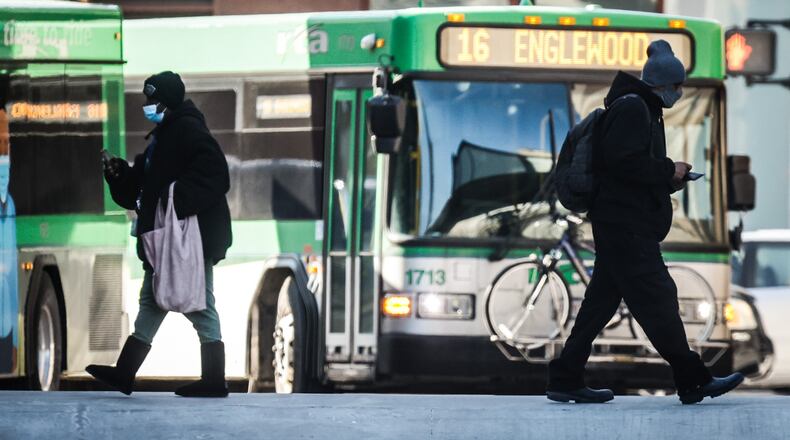The ridership reductions caused by COVID are likely to be a long-term challenge that might require new service-delivery models and schedules, based on resources and riders’ needs, the public transit agency said.
RTA recently reduced service on many of its fixed-route bus lines in response to staff shortages and call-offs due to COVID, but the agency already is looking at options to increase service as staffing levels improve this year and beyond, CEO Robert Ruzinsky said.
“Many of our riders are essential workers themselves, and we want to ensure they’re receiving a reliable service they can depend on, despite the higher absenteeism we are experiencing due to COVID,” he said.
Some customers say longer waits for buses are inconvenient.
While service reductions related to COVID are completely understandable, they harm people who do not drive or own cars, said Ellis Jacobs, an attorney with Advocates for Basic Legal Equality.
“Service reductions create problems for riders and can lead to a downward spiral of ridership and service,” he said. “RTA should restore service as soon as it can.”
2020 was a tough year for the transit agency because of the pandemic, and fixed-route ridership declined by more than 35%.
Since June, fixed-route bus boardings have remained below 2020 levels, though the gap has narrowed.
RTA fixed-route buses had 396,985 riders in December, a decrease of 1.2% from the final month of 2020.
The Flyer, which is the free shuttle between downtown and Brown Street near University of Dayton, saw ridership increase last year, as did the RTA’s Connect On-Demand door-to-door service.
Jacobs, with ABLE, said people depend on public transportation to get to their jobs and vital destinations, like medical appointments and the grocery store.
About 45% of RTA customers rely on the agency to get to work; about 15% catch the bus to go shop, and 12% take buses to get to medical and doctor appointments, according to a survey of riders in 2020 and 2021.
More than 90% of RTA riders say they do not have a vehicle they could use instead of the bus to get around, the survey found, and most customers ride the bus every day.
Citing challenges related to COVID, the Greater Dayton RTA has temporarily reduced services that impact 14 routes, switching to a Saturday service schedule every day of the week, except Sundays.
Most routes now have a daytime frequency between 34 and 100 minutes, and customers traveling at night to have to wait about 75 minutes or longer for their buses to arrive.
The RTA developed contingency service plans to prepare for expected federal vaccine mandates, which could have led to unvaccinated staff being placed on leave, Ruzinsky said.
Federal vaccine mandates have not been implemented, but the RTA switched to a Saturday service plan because of rising call-offs during the Omicron surge, even though nine in 10 transit employees are vaccinated, Ruzinsky said.
Customers standing at bus stops, especially during the winter, need to know that a bus is coming, even if there is a longer wait, Ruzinsky said.
The reduced service schedule ensures that all current routes continue to run, just less frequently, he said.
“It also offered the lowest level of customer confusion,” he said. “A Saturday service .... was also easy for our riders to understand — they only had to look at our current Saturday schedules to know the bus times.”
Last summer the RTA temporarily eliminated some routes that it said was necessary owing to a significant shortage of bus drivers and decreased customer demand.
Tim Mills, 41, rides the bus every day, and it’s how he gets from his home in South Park to his job at GameStop at the Eastown Shopping Center.
Mills, a single dad, said his bus used to come every 15 to 20 minutes — 25 minutes tops —but it now comes every 45 minutes during daytime hours.
“It’s awful,” he said. “It’s not convenient whatsoever.”
Greater Dayton RTA’s temporary service adjustments:
Day Frequency (5:30 a.m. – 6:30 p.m.)
Route 1: 40 minutes
Routes 2, 4, 12: 45 minutes
Route 7: 34 minutes
Route 8: 28 minutes
Route 9: 42 minutes
Route 11, 14, 16, 17, 18, 19: 100 minutes
Route 34: 90 minutes
Night Frequency (6:30 p.m. – 12:30 a.m.)
Routes 1, 2, 4, 7, 8, 9, 12: 75 minutes
Route 11, 14, 16, 17, 18, 19: 100 minutes
Route 34: 90 minutes
There have been no service changes to routes 22, 43, 55 and the Flyer, the free shuttle between downtown and Brown Street.
Greater Dayton RTA fixed-route bus ridership
2019: 9,192,610
2020: 5,911,955
2021: 5,141,944
About the Author




